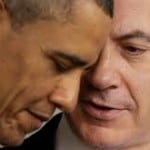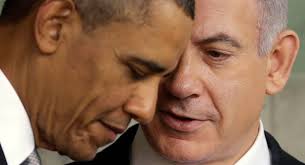Gil Ronen with Israel National News.
During last year’s UNGA meeting, Obama had time for an appearance on “The View,” but not to meet Netanyahu. Has something changed?
Prime Minister Binyamin Netanyahu has postponed the date of his upcoming speech in the United Nations General Assembly from September 30 to October 1, so that he can meet with US President Barack Obama in the White House.
Maariv reports that the rescheduling took place because September 30 is the only day on which Obama could meet Netanyahu, due to the fact that the rest of his schedule is devoted to meetings regarding healthcare.
The report is almost purely technical. Who hasn’t rescheduled meetings in order to fit them into a tight schedule? But there may be diplomatic significance between the lines.
Meetings between Israeli prime ministers and US presidents are an almost routine matter in the autumn season, when the United Nations General Assembly convenes and world leaders make pilgrimage to New York. And yet, Netanyahu and Obama did not meet last year, although Netanyahu quite publicy desired the meeting.
Both men were in New York City for the General Assembly. At the time, there was great tension between the two over the matter of the Iranian nuclear threat. With Ehud Barak as defense minister, Israel was making unmistakable “hold me back” noises, threatening to launch a unilateral preemptive strike against Iran, partly due to a feeling that its growing sense of an existential threat was being met with a very cold US shoulder.
Netanyahu made his famous “red line” speech at the UN, highlighting the immediate danger posed by Iran’s nuclear weapons program; but Obama, who was in the middle of his reelection campaign, did not find time in his schedule to meet Netanyahu.
Notably, Obama did find time during his New York stay to appear on ABC’s “The View,” together with his wife Michelle, where he joked with the female presenters – “I’m just supposed to be eye candy here for you guys.” The disconnect between Israel’s dire situation and Obama’s lightheaded state of mind could not have been starker.
In previous years, too, occasions on which Netanyahu and Obama met were characterized by visible tension and very bad blood. In March of 2010, he was treated rudely by Obama in the White House, reportedly after being let in through a back entrance.
“For a head of government to visit the White House and not pose for photographers is rare,” wrote Fox News at the time. “For a key ally to be left to his own devices while the President withdraws to have dinner in private was, until this week, unheard of. Yet that is how Benjamin Netanyahu was treated by President Obama on Tuesday night, according to Israeli reports on a trip viewed in Jerusalem as a humiliation.”
One Israeli newspaper called the meeting “a hazing in stages,” poisoned by mistrust. The British Telegraph reported that Netanyahu “was left to stew in a White House meeting room for over an hour after President Barack Obama abruptly walked out of tense talks to have supper with his family”, after being presented with a list of 13 demands.
Two months later, it was Netanyahu who “humiliated” Obama by rebuking him on live television, ahead of the AIPAC convention.
“Netanyahu appeared to lecture Mr. Obama following their nearly two-hour meeting Friday—exposing tensions between leaders over Mideast policy that are usually kept out of the public eye,” wrote the Wall Street Journal. “Before cameras and reporters in the Oval Office Friday afternoon, Mr. Netanyahu turned to face the president while telling him Israel ‘cannot go back to the 1967 lines’ that are ‘indefensible.’”
What has changed since then? Possibly, nothing susbstantial. If Norman Podhoretz is correct in his recent Wall Street Journal assessment – Obama’s foreign policy failures and apparent inconsistencies are all part of a calculated, sophisticated, long range maneuver designed to implement a policy of extreme American isolationism.
There is another possibility, however. That possibility is that Obama’s foreign policy thinking has been following some kind of learning curve, and that reality in the Middle East, as well as within the US media world, have opened his eyes to see just a little bit of light.
According to this more optimistic analysis, Obama’s attempt to face off with Putin and Assad over Syria’s chemical weapons crimes, pathetic and amateurish as they may have seemed to many, do indicate that he wants to act against weapons of mass destruction in the Middle East, or somehow “do the right thing,” if only because liberal publications in the US have been hammering him on the subject.
After his policies in Egypt and Syria exploded in his face, his Cairo Speech dreams of a new Middle East devolved into an Islamist chaos, and with Iranian “engagement” taking the form of threats against his family, Obama may also be more aware, somewhere deep inside his political persona, of the seriousness of the threats Israel faces. Possibly, his original antipathy for Israel and Netanyahu may have been tempered by the reality of living in the White House for almost five years.
The upcoming UNGA is a moment of great historic drama. Binyamin Netanyahu can be expected to be in top form. All of his warnings over the years have materialized. The danger of WMDs in the hands of rogue states have been demonstrated for the world to see, in Youtube videos of dead children lying in rows. Last year – the feeling was that while Netanyahu drew his red line, Obama had probably flipped the channel on his TV set. This year, however, Obama has also drawn a red line, and has had to try to defend it.
Perhaps, at last, Netanyahu’s red line has met Obama’s foreign policy learning curve, in which case there is room for very cautious optimism. This time, perhaps, the meeting between the two leaders will not involve snubs and public rebukes, but take place in an atmosphere that is conducive to understandings that can truly deter Iran and Russia from continuing their game of nuclear chicken with the US and Israel.
